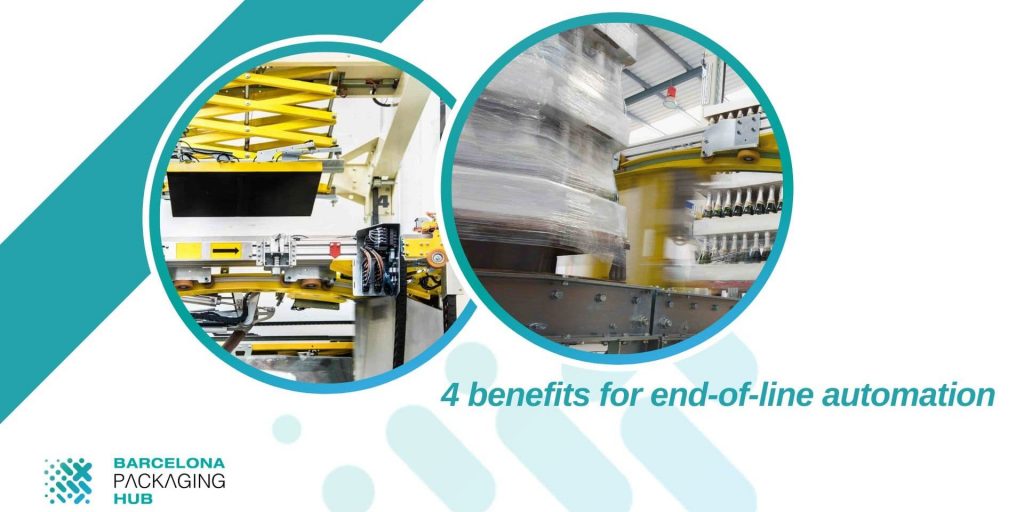If your production flow is expanding, if your current end-of-line process is slow, if you want to reduce labor absenteeism or if you are failing to meet your sustainability goals, it is time to leave manual processes in the past and automate your end-of-line.
First of all, what does industrial automation mean?
The aim is to reduce the work performed by people in production processes as part of initiatives in factories. As a general rule, the workers’ tasks are limited to monitoring operations from a control panel.
Manual? No thanks.
In many companies, in the past, few resources were allocated to the end of line, with the consequent decision to choose a team of workers to manually wrap or wrap the palletized loads.
Stretch wrapping is the operation by which loads are secured on the pallet using stretch film.
Wrapping is necessary for handling and transportation, especially for those products that require greater protection against external agents such as foodstuffs or raw materials involved in their transformation.
The plastic film acts as a lateral barrier, reducing the entry of dust and other agents through gaps in the packaging. The stretch wrapping operation is performed by unfolding a reel of stretch film and wrapping it around the load. The mechanical procedures by which the load is wrapped are varied, the current trend being to improve the speed and efficiency of the automatisms.
Main problems of manual processes
Currently, the mostadvanced automatic models replacing manual processes are ring stretch wrappers, capable of reaching speeds of over 150 pallets/hour, compared to rotating arm equipment for medium production and rotating base equipment that rotates the pallet, with the risk of shifting the load.
Can you imagine, today, four or five employees hand-wrapping loads destined for a more and more demanding logistics system? Exactly, it is unthinkable.
We list some of the frequent problems caused by manual processes:
- Unstable or unstable loads with consequent excessive consumption of consumables: no manual wrapping, no matter how professional, can ever optimize the relationship between load stability and low film consumption
- High costs, injuries or labor accidents: Factory workers will be responsible for wrapping the loads one by one. The manual method is slower, more expensive and may cause more physical discomfort.
- Image of the company damaged by the final finish: It can happen that batches of your products are rejected because of a bad appearance, which can result from unstable manual wrapping that makes handling dangerous, crumbling on the truck or during loading and/or unloading, generating customer dissatisfaction and loss of loyalty.
End-of-line automation in industry has many benefits
An automatic wrapping machine is a very good investment that will optimize your processes and your production, and will improve the image of your company and the health of your operators.
Automatic stretch wrapping machines are those that do not require any operator intervention during the stretch wrapping process and are designed to optimize the production process.
It plays a very important role in modern industry: the baler contributes, to a greater or lesser extent and depending on the quality of the machine, to:
- Improve efficiency, save on film consumption: automation increases production speed, reducing human error and increasing process efficiency. Compared to manual shrink wrapping, there is practically no plastic waste with automatic shrink wrappers, as the reels are fully utilized until the plastic is used up.
- Reduce costs: labor costs are reduced, improving production efficiency, resulting in a significant reduction in costs. Automating processes reduces labor costs by 60% in the use of semi-automatic balers or 90% in the use of automatic balers. Not to mention the improvement of the physical and working conditions of the operators, since physical efforts are reduced, reducing the physical discomfort caused by manually wrapping a pallet and reducing absenteeism due to sick leave. Costs for returns and repackaging are almost completely reduced.
- Improved safety: reduced risk of occupational injuries and improved workplace safety.
- Improve quality: automation can ensure greater consistency and accuracy in production, while improving the quality of the final product finish. An automatic packaging machine enhances your company’s image by improving the pallet finish. The stretch wrapper applies a regular and uniform film, leaving the pallet in perfect condition. The best finish is achieved by those balers that have a cutting and welding system that avoids the annoying film tails that cause so many problems in automatic warehouses and forklift wheels.
Automatic rotary ring stretch wrappers, a bet for end-of-line automation
Our partner Movitec’s automatic rotary ring stretch wrappers can do that and more:
- Manufactured with proven, world-renowned components, quality that will extend the life of the machine.
- Machines designed, built and programmed for easy maintenance with a global network of technicians to provide the best service.
- Significant film savings, thanks to its pre-stretch of up to 400% (i.e. one meter of film stretches up to four meters), combined with its excellent control of film tension on the load, which makes it possible to apply very thin film without tearing.
- Flexibility of wrapping cycles, choosing a la carte the program that best suits your load, automatically.
- Small loads, high loads, XL loads, with or without pallet, Movitec’s range of stretch wrappers can handle it all.
In summary, end-of-line automation in the industry, choosing a good quality stretch wrapper, with a good quality film, has a very positive impact on efficiency, quality and safety, which can help improve competitiveness and business success.


